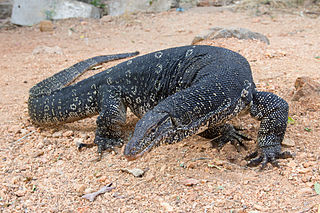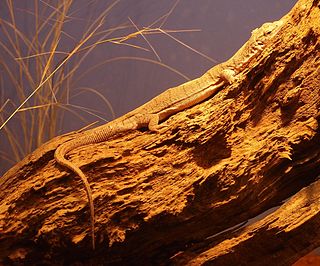
The Komodo dragon, also known as the Komodo monitor, is a member of the monitor lizard family Varanidae that is endemic to the Indonesian islands of Komodo, Rinca, Flores, and Gili Motang. It is the largest extant species of lizard, growing to a maximum length of 3 m (9.8 ft), and weighing up to 70 kg (150 lb).

Monitor lizards are lizards in the genus Varanus, the only extant genus in the family Varanidae. They are native to Africa, Asia, and Oceania, and one species is also found in the Americas as an invasive species. About 80 species are recognized.

Crotalus cerastes, known as the sidewinder, horned rattlesnake or sidewinder rattlesnake, is a pit viper species belonging to the genus Crotalus, and is found in the desert regions of the Southwestern United States and northwestern Mexico. Like all other pit vipers, it is venomous. Three subspecies are currently recognized.

A goanna is any one of several species of lizard of the genus Varanus found in Australia and Southeast Asia.

The Bengal monitor, also called the Indian monitor, is a monitor lizard distributed widely in the Indian Subcontinent, as well as parts of Southeast Asia and West Asia. This large lizard is mainly a terrestrial animal, and its length ranges from about 61 to 175 cm from the tip of the snout to the end of the tail. Young monitors may be more arboreal, but adults mainly hunt on the ground, preying mainly on arthropods, but also taking small terrestrial vertebrates, ground birds, eggs and fish. Although large Bengal monitors have few predators apart from humans who hunt them for meat, younger individuals are hunted by many predators.

The perentie is a species of monitor lizard. It is one of the largest living lizards on earth, after the Komodo dragon, Asian water monitor, and the Crocodile monitor. Found west of the Great Dividing Range in the arid areas of Australia, it is rarely seen, because of its shyness and the remoteness of much of its range from human habitation. The species is considered to be a least-concern species according to the International Union for Conservation of Nature.

The Mexican beaded lizard is a species of lizard in the family Helodermatidae, one of the two species of venomous beaded lizards found principally in Mexico and southern Guatemala. It and the other members of the same genus, including the Gila monster, are the only lizards known to have evolved an overt venom delivery system. The Mexican beaded lizard is larger than the Gila monster, with duller coloration, black with yellowish bands. As it is a specialized predator that feeds primarily upon eggs, the primary use of its venom is still a source of debate among scientists. This venom has been found to contain several enzymes useful for manufacturing drugs in the treatment of diabetes, and research on the pharmacological use of its venom is ongoing.

The Asian water monitor is a large varanid lizard native to South and Southeast Asia. It is widely considered to be the second-largest lizard species. It is distributed from eastern and northeastern India and Bangladesh, the Andaman and Nicobar Islands, Sri Lanka, through southern China and Hainan Island in the east to mainland Southeast Asia and the islands of Sumatra, Borneo, Java, Lombok, the Riau Archipelago, Sulawesi. It is one of the most widespread monitor lizards.

The lace monitor, also known as the tree goanna, is a member of the monitor lizard family native to eastern Australia. A large lizard, it can reach 2 metres (6.6 ft) in total length and 14 kilograms (31 lb) in weight. The lace monitor is considered to be a least-concern species according to the International Union for Conservation of Nature.

The black tree monitor or Beccari's monitor is a species of lizard in the family Varanidae. The species is a relatively small member of the family, growing to about 90–120 cm (35–47 in) in total length. V. beccarii is endemic to the Aru Islands off New Guinea, living in an arboreal habitat. The skin color of adults is completely black, to which one common name refers.

The western diamondback rattlesnake or Texas diamond-back is a rattlesnake species and member of the viper family, found in the southwestern United States and Mexico. Like all other rattlesnakes and all other vipers, it is venomous. It is likely responsible for the majority of snakebite fatalities in northern Mexico and the greatest number of snakebites in the U.S. No subspecies are currently recognized.

The Indian grey mongoose or Asian grey mongoose is a mongoose species native to the Indian subcontinent and West Asia. It is listed as Least Concern on the IUCN Red List.

The yellow-spotted monitor, also known as the Argus monitor, is a monitor lizard found in northern and western regions of Australia and southern New Guinea.

The spiny-tailed monitor, also known as the Australian spiny-tailed monitor, the ridge-tailed monitor the Ackie dwarf monitor, and colloquially simply ackie monitor, is an Australian species of lizard belonging to the genus of monitor lizards (Varanus).

The Anguimorpha is a suborder of squamates. The group was named by Fürbringer in 1900 to include all autarchoglossans closer to Varanus and Anguis than Scincus. These lizards, along with iguanians and snakes, constitute the proposed "venom clade" Toxicofera of all venomous reptiles.

The Gila monster is a species of venomous lizard native to the Southwestern United States and the northwestern Mexican state of Sonora. It is a heavy, slow-moving reptile, up to 56 centimetres (22 in) long, and it is the only venomous lizard native to the United States. Its venomous close relatives, the four beaded lizards inhabit Mexico and Guatemala. The Gila monster is sluggish in nature, so it is not generally dangerous and very rarely poses a real threat to humans. However, it has a fearsome reputation and is sometimes killed despite the species being protected by state law in Arizona.

The pygmy mulga monitor, also known commonly as Gillen's monitor or just the mulga monitor, is a species of lizard in the family Varanidae. The species is endemic to Australia.

The Rosenberg's monitor is an Australian species of varanid reptile found in southern regions of the continent. They are large and fast predators with rugged bodies and long tails, having a combined length up to 1.5 metres, that will consume any smaller animal that is pursued and captured or found while foraging. They occur in the Australian Capital Territory, New South Wales, South Australia, Victoria, where it may be rare or locally common, and more frequently observed in Western Australia, where it is sometimes abundant.

Hapturosaurus, sometimes known as the tree monitors, is a subgenus of lizards, consisting of slender-bodied arboreal monitor lizards mostly found in the tropical rainforests of Indonesia and Papua New Guinea.























